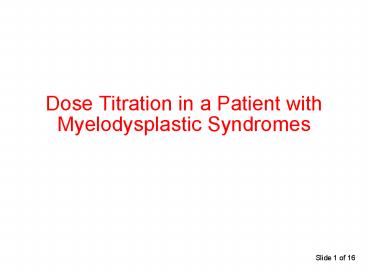Dose Titration in a Patient with Myelodysplastic Syndromes - PowerPoint PPT Presentation
1 / 16
Title:
Dose Titration in a Patient with Myelodysplastic Syndromes
Description:
The cornerstone of therapy in patients with myelodysplastic ... diarrhea continues to be unmanageable on reintroduction, deferasirox should be discontinued ... – PowerPoint PPT presentation
Number of Views:98
Avg rating:3.0/5.0
Title: Dose Titration in a Patient with Myelodysplastic Syndromes
1
Dose Titration in a Patient with Myelodysplastic
Syndromes
2
Background
- The cornerstone of therapy in patients with
myelodysplastic syndromes (MDS) is supportive
care with blood transfusions - With a median survival of 4060 months,
International Prognostic Scoring System (IPSS)
low-risk and intermediate-1-risk MDS patients
live long enough to develop clinical consequences
of iron overload
3
Background
- Complications of iron overload include heart
failure/arrhythmias, liver disease, and diabetes
mellitus - Transfusion dependency has a significant impact
on survival in MDS1 - A 30 greater risk of death was evident for
every500 ng/mL increase in serum ferritin
above1000 ng/mL1
1. Malcovati L, et al. J Clin Oncol.
2005237594-7603.
4
Patient Presentation
- 69-year-old female patient with IPSS Int-1-risk
MDS presented with baseline serum ferritin level
of 3214 ng/mL
5
Treatment History
- Patient has been transfusion-dependent for 2
years, receiving 2 units of packed red blood
cells per month - She has had no prior chelation therapy
6
Question
- Should this patient be started on chelation
therapy? - A. No
- B. Yes, with deferiprone
- C. Yes, with deferasirox
7
Initiation of Chelation Therapy
- Iron chelation should be initiated when serum
ferritin levels 1000 ng/mL - The patients serum ferritin is considerably
above that level and she is expected to live long
enough to be at risk of clinical complications of
iron overload - Chelation therapy should be initiated
8
Choosing a Chelator
- Although deferasirox is approved for use in
patients with MDS, deferiprone is not approved
for this indication and thus is not an
appropriate choice - Therefore, treatment with deferasirox was
initiated at 20 mg/kg/day - Desferrioxamine, also approved for use in MDS,
would be an acceptable alternative. However, the
IV infusions required with desferrioxamine would
place an unnecessary burden on an elderly patient
9
Question
- After 2 weeks, the patient began to experience
moderately severe diarrhea. How should the
diarrhea be managed? - A. Supportive therapy with antidiarrheal
medication and hydration only - B. Supportive therapy as above, plus dose
reduction - C. Interruption of therapy until diarrhea
resolves
10
Managing Deferasirox-Related DiarrheaMild to
Moderate
- The patient was given an antidiarrheal medication
and adequate hydration was maintained - Despite these measures, diarrhea episodes
continued to occur - Deferasirox dose was reduced to 10 mg/kg/day
- After 1 week, diarrhea episodes had fully
resolved - Deferasirox dose was gradually increased over the
subsequent 2 weeks to 20 mg/kg/day in increments
of 5 mg/kg/day - With severe diarrhea, deferasirox should be
interrupted, then reintroduced at 10 mg/kg/day
and gradually escalated if diarrhea continues to
be unmanageable on reintroduction, deferasirox
should be discontinued
11
Response to TreatmentSerum Ferritin
- Following 6 months of treatment, patients serum
ferritin levels remained essentially unchanged
from baseline (3145 ng/mL)
12
Question
- What should the next step be?
- A. Switch to desferrioxamine
- B. Consider deferiprone
- C. Increase dosage of deferasirox
13
Dosage Titration
- Since inadequate dose titration may be the cause
of suboptimal response, this possibility should
be explored - Deferasirox dose was increased to 30 mg/kg/day
- By month 9, serum ferritin levels had decreased
to 2759 ng/mL and by month 12 they had been
further reduced to 2504 ng/mL - Patient is continuing to receive deferasirox 30
mg/kg/day and steady decreases in serum ferritin
levels have been observed - No further adverse events have been noted
14
Deferasirox Therapy in MDS Induces Dose-Dependent
Changes in Iron Burden
In MDS patients, iron balance was achieved with
10 mg/kg/dand negative iron balance with 20 and
30 mg/kg/d
LIC liver iron concentration. Porter JB, et al.
Eur J Haematol. 200880168-176.
15
ConclusionsDiarrhea
- Mild diarrhea can be managed with supportive
care, without the need for dosereduction/disconti
nuation of treatment - Depending on severity, moderate diarrhea may
require temporary dose adjustment - Once the diarrhea has resolved, deferasirox
dosage can be gradually escalated from 10
mg/kg/day in steps of 5 mg/kg/day until the
target dose is reached
16
ConclusionsSerum Ferritin
- MDS patients receiving regular blood transfusions
are at risk of developing chronic iron overload
and may require chelation therapy - According to current guidelines, chelation
therapy should be initiated once serum ferritin
levels 1000 ng/mL - Deferasirox dose should be reviewed regularly
at3- to 6-month intervals and adjusted according
to trends in serum ferritin levels
Gattermann N. Leuk Res. 200731(Suppl 3)S10-S15.































